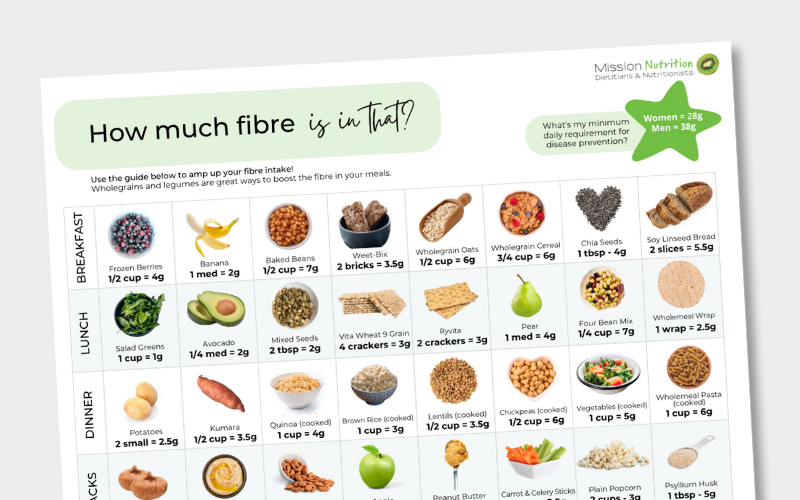Date
21.06.2024

Fibre is essential to feed our healthy gut microbiota and allow them to produce short chain fatty acids that keeps the environment of our gut healthy and strong. Fibre also gives the gut a ‘workout’ as it passes through making it less susceptible to becoming ‘leaky’ and letting bacteria and pathogens through into our blood stream that could harm us.
How much fibre do you need?
The minimum daily requirement is 28gm for women and 38gm for men (many people eat less than 20gm)!
There are 3 different types of fibre, ALL are important. As you will see, these are WHOLE foods. One of the issues with the heavily processed foods that say they are ‘high in fibre’ is that they may just have something like inulin added to them, which yes increases the fibre on the nutritional information panel, but… it is NOT the same as getting a variety of fibres from real food!!
Soluble - Soluble fibre dissolves in water to form a thick gel. This slows the time it takes food to pass through the stomach and small intestine, which helps absorb nutrients from your food. It’s found in oats, barley, psyllium, fruits with the skin on, vegetables and legumes.
Insoluble - Insoluble fibre is what people often refer to as ‘roughage’ and it speeds up the time it takes for waste to move through the large intestine, which helps to produce larger, softer stools and reduces the time toxins stay in the bowel. Insoluble fibre is found in wholegrain cereals, pasta, rice and quinoa.
Resistant starch - Resistant starch is fermented by good bacteria in the bowel, which produces short-chain fatty acids (a type of fat) that are important for the health of cells in the bowel, and our overall health. Pulses, cold cooked potatoes and pasta as well as bananas with a green tinge!
What does 28gm-38gm look like?
To give you an idea, here are some common food sources and approx how much fibre they contain:
1 cup cooked veggies 5gm
2 weetbix 3.5gm
1 cup cooked brown rice 3gm
1 banana 2gm
How do you get more?
Enjoy wholegrain foods three to four times a day and legumes (such as beans, chickpeas and lentils) two to three times a week.
>> Download our FREE resource How much fibre is in that?
This will help you figure out how much you’re currently getting and how much more you might need, plus give you lots of ideas on food sources to help you up your intake.
Related: Find out all about Gut Health and how to improve yours!
If you would like personalised nutrition advice to help you with managing a balanced diet and lifestyle, the team here at Mission Nutrition would love to help! Check our booking page to find the Nutritionist or Dietitian who is best to support your needs, or get in touch and our Clinic Manager Hayley will be happy to assist you!
21.06.2024
Hayley Farnworth
Articles
Mission Nutrition Dietitians and Nutritionists © 2025.
Terms and Conditions